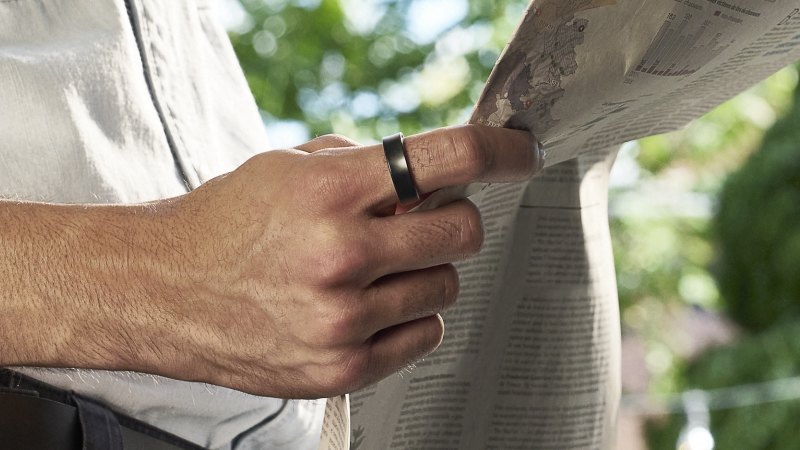
Almost all new categories of smart device are introduced to a healthy dose of scepticism and many calls of “nobody asked for this”, and smart rings are no exception. You can’t deny that getting the batteries, chips, sensors and connectivity gear into a ring, and having it be sturdy, is impressive. But is it compelling as a product? Previously, I didn’t really think so.
But after a few weeks with Samsung’s Galaxy Ring, I’m beginning to see the appeal. Or, at least, I can see how the category is onto something that could catch on. In essence, it’s a way to get data about your body and movements onto a central health metrics system.
Like a smartwatch, but without the small touch-screen computer on your arm, it collects information that can be turned into graphs of your heart rate, insights about your sleep, and records of your exercise. The ring works as a kind of proof of concept; all you need is something with the right sensors that can sit comfortably on a user’s skin at all times, and they can get the benefits of tracking that we’ve typically associated only with bulky straps or more intrusive devices. Although for $700 you could get a smartwatch instead, the Galaxy Ring is perfect for scooping up all that data without you really having to do anything.
The Galaxy Ring experience starts with sizing, which means you’ll have to try out some plastic loops from Samsung’s sizing kit for a few days to find which one is suited to your fingers. The ring is a bit different from standard jewellery, since it has an array of sensors that sits on the underside of your finger, so it’s worth really committing to this step to make sure it fits. The Galaxy Ring’s case lights up to show how much charge is left.
Credit: Bloomberg The real thing is a titanium band coloured black, silver or gold. It’s very plain and very light, to the point that you might not be able to tell the difference between it and the plastic sizers if it wasn’t for the glowing green and red sensors (and the fact that it’s noticeably very strong and rigid). You can put it on any finger (there’s a small bump on the outside to show you where the sensors are; keep that part on the underside), and then more or less forget it’s there.
The ring is waterproof, it never gets hot, it doesn’t have a screen or a vibration motor; as far as smart devices go it’s especially inert. But it has a battery that will last at least seven days, and comes with a funky clear storage box that can store the same amount of power. If you leave this box at home and plugged in you just need to put the ring in for an hour a week, and if you’re going somewhere, you can take the box to get two full weeks without needing a charge.
Initial setup is seamless; you just open the case near a Samsung phone and the ring will pair up via Bluetooth. From there, it works just like a smartwatch. Periodically, the ring will send the data it’s collected to the phone, where it’s crunched and integrated with the Samsung Health app.
As a platform, I tend to find a bit less informative than Apple Health or Fitbit, but it is comprehensive and covers all the bases you’d expect. With the ring on, I get a steps counter, an estimate of my active minutes and an idea for the energy I’ve burned throughout the day. I get notifications to move if I’ve sat still too long, exercise such as running is automatically tracked, and my heart rate, blood oxygen saturation, respiratory rate and “stress” is measured thanks to the sensors and thermometer.
While you sleep, the ring turns its measurements into a map of your movements through light, deep and REM cycles, and scores your sleep out of 100 based on this data plus time slept and consistency. Over the past few weeks, I’ve compared the results from the ring to other watches and trackers, and it tends to be very close. The ring itself has no screen or feedback.
All data goes into Samsung’s phone apps. Samsung Health turns this data into a daily “energy score” that’s supposed to let you know how ready your body is for training. It will also give a quick paragraph of advice, such as ideas for extra activities if you haven’t been hitting your goals.
I think most athletes and people serious about their workouts are going to prefer a watch, for the extra sensors and capabilities such as music playback, workout plans and real-time stat readouts. But if you’re just keeping an eye on your steps, sleep and daily workout, the ring does a great job. Outside of that, there isn’t much to it.
If you lose the ring, its last known location will appear in Samsung Find, and while it can’t vibrate or make noise, you can set it to blink its sensors to make it easier to locate (which I was thankful for at one point when it slipped off while I was doing the laundry). And the ring can detect when you smack the finger it’s on against your thumb or palm twice in a row, but currently you can only set this to snooze alarms or remotely take a photo. If what you want is a way to collect health metrics without a watch, the Galaxy Ring works, and I really only have two concerns.
First is that it’s very expensive, to the point that you could probably get both a Galaxy Watch FE and a regular titanium ring for less. And since the Galaxy Ring isn’t particularly attractive as a ring, it’s going to be difficult to justify. The second concern is a bit speculative, but it’s about longevity.
The tiny battery in this thing is bound to start giving out within two years, and at some point will become entirely useless. There’s no way to repair it (either if the battery runs out or if it’s somehow crushed, which is not unheard of for rings), so like most earbuds, it’s as disposable as tech can get. Of course, with earbuds, people may be happy to upgrade every few years to get new features or tech, but I’m not sure what can be added to a ring, except maybe a promise that it won’t end up as e-waste in 30 months’ time.
Get news and reviews on technology, gadgets and gaming in our Technology newsletter every Friday. Sign up here..














